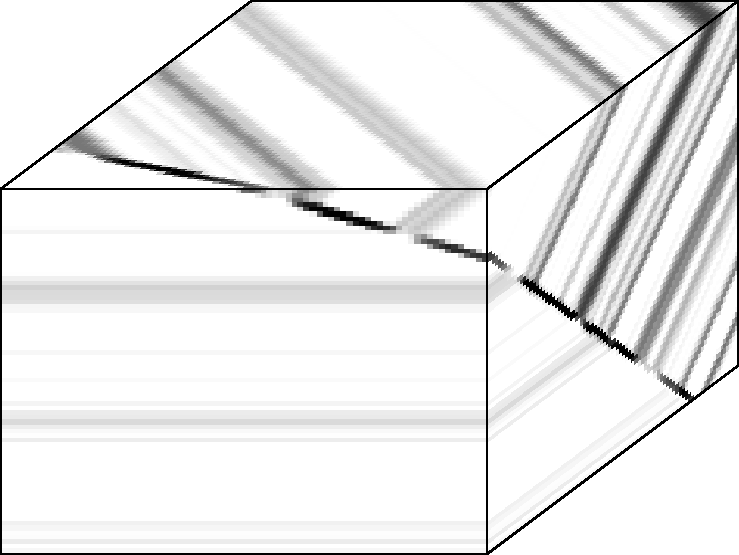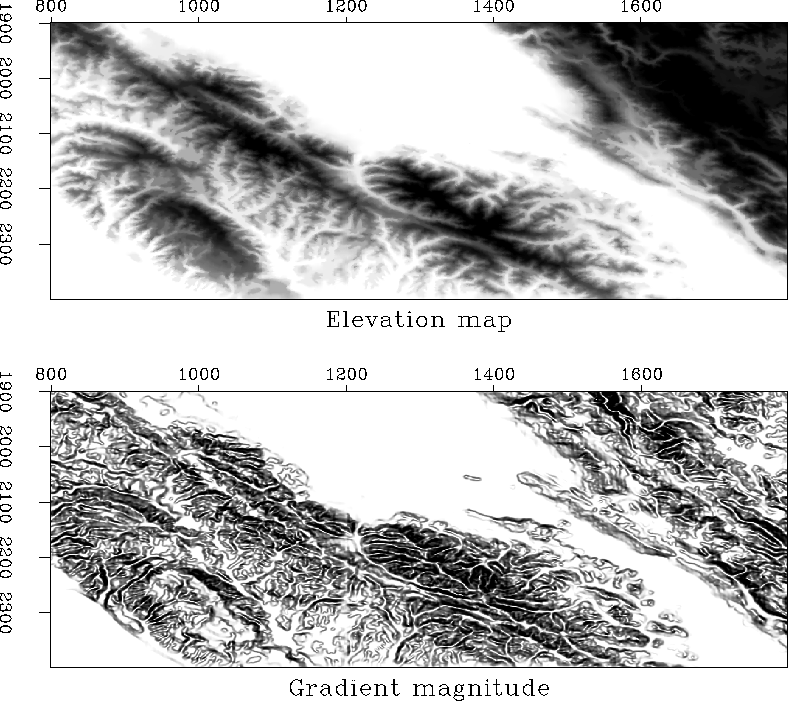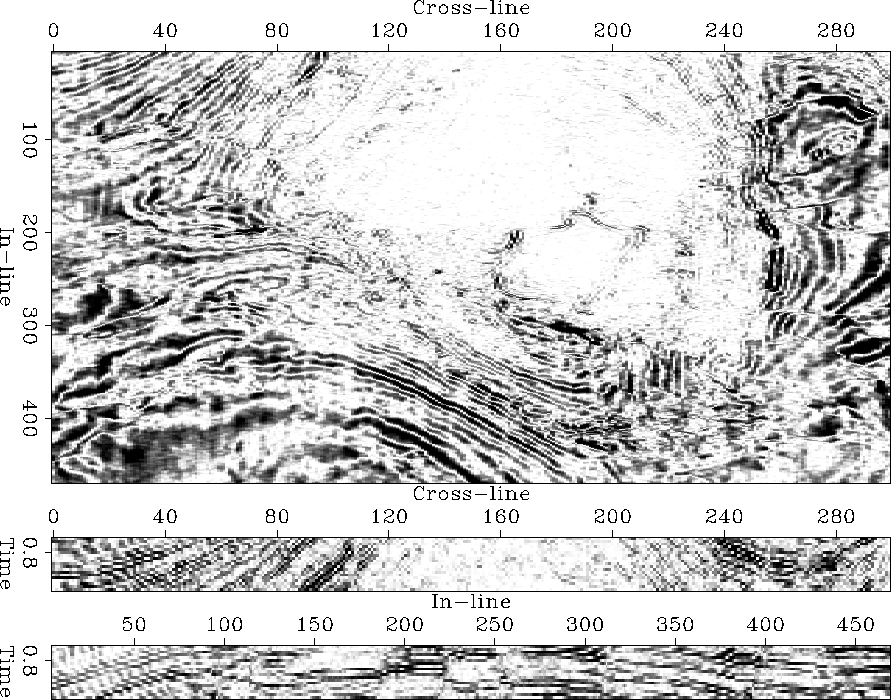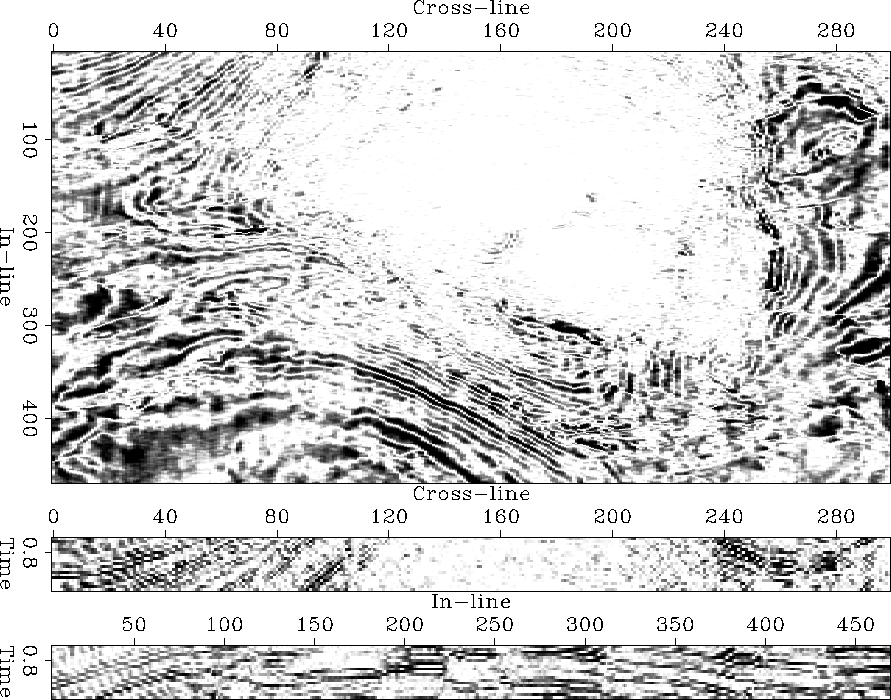




Next: Image and physical space
Up: Gradient magnitude operator
Previous: Gradient magnitude operator
The gradient magnitude operator does have its desired edge enhancing effect
on non-oscillatory images, such as the
synthetic data in Figure 13
or the Bay Area map in Figure 14.
The synthetic test image on the left of Figure 13
consists of three constant-amplitude regions that are separated by
two parallel planes.
The gradient magnitude map on the right delineates the two boundary planes.
The top panel of Figure 14 shows
the Bay Area topography.
The gradient magnitude operator
distinguishes
topographic features by their slope.
In contrast to the Bay Area's smooth sloping hills,
the magnitude map's multiple areas of zero gradient
surprisingly imply a step-like landscape.
I assume that the original topography data was probably
sloppily interpolated from a contour map.
In general,
edge detection and
discontinuity attributes often reveal
such image shortcomings.
bayGrad
Figure 14
Gradient magnitude operator applied to Bay Area topography.
The top panel shows the topographic elevation of
the San Francisco Bay Area.
In the bottom panel,
the gradient magnitude operator
successfully enhanced the topographic edges,
such as ravines and canyons.
The terraced appearance is an artefact of the original data.





However,
applied to oscillatory images,
such as the synthetic test case in Figure 15,
the gradient magnitude operator
indiscriminately amplifies
the plane-wave layer boundaries
as well as the
discontinuity between the plane-wave volumes.
Consequently,
the plane-wave layers are not suppressed
and the central fault is not isolated.
The amplitude along the enhanced discontinuity surface
varies irregularly depending on the amplitude contrast
of the adjacent sedimentary layers.
zeroFoltGrad
Figure 15
Gradient magnitude operator applied to synthetic test case.
The gradient magnitude operator fails to isolate the fault,
because it cannot differentiate between
the amplitude change across the fault
and
the amplitude change across the sedimentary layers.
|
|  |





Similarly,
the gradient magnitude operator fails to delineate the faults
of the seismic image example of Figure 16.
The operator increases the overall frequency contents of
the image, but does not suppress the sedimentary layer packages.
The steeply inclined layers appear aliased in the vertical sections.
The faults are hidden among the layer boundaries.
Faults, such as the exemplary R fault
of the original image 8,
can be identified only if one knows where to
search for them.
The so-identified faults are, however, often only one-pixel wide
and, consequently, well resolved.
The salt truncating fault is not particularly enhanced.
Its position is indirectly indicated by a change in the salt bodies
average gradient magnitude.
Similarly, the boundaries of the salt dome are not clearly
pinpointed.
In the case of the Gulf salt dome and the North Sea horst,
the gradient operator
fails to isolate the faults and
yields a map that is as difficult to interpret as
the original seismic image.
gulfFoltTotGrad
Figure 16
Gradient magnitude operator applied to salt image.
The gradient magnitude operator fails to suppress
the image's sedimentary layers.





gulfFoltTotWGrd
Figure 17
Weighted gradient magnitude operator applied to salt image.
In contrast to Figure 16,
this image is the gradient magnitude of the pseudo-depth space,
not simply the pixel space.










Next: Image and physical space
Up: Gradient magnitude operator
Previous: Gradient magnitude operator
Stanford Exploration Project
3/8/1999



